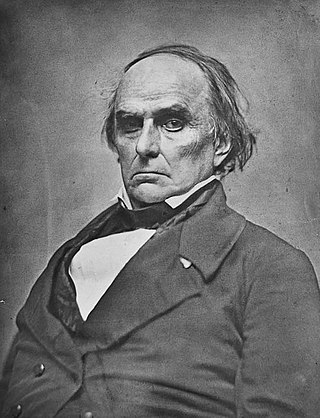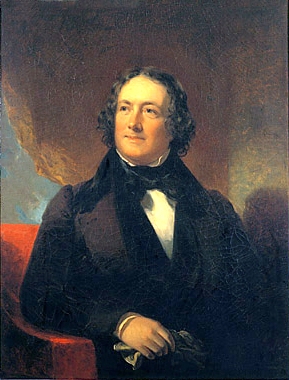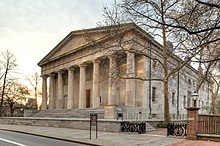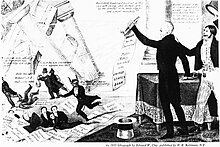
Andrew Jackson was an American lawyer, planter, general, and statesman who served as the seventh president of the United States from 1829 to 1837. Before his presidency, he gained fame as a general in the U.S. Army and served in both houses of the U.S. Congress. Often praised as an advocate for ordinary Americans and for his work in preserving the union of states, Jackson has also been criticized for his racial policies, particularly his treatment of Native Americans.

The Republican Party, retroactively called the Democratic-Republican Party, and also referred to as the Jeffersonian Republican Party among other names, was an American political party founded by Thomas Jefferson and James Madison in the early 1790s that championed liberalism, republicanism, individual liberty, equal rights, decentralization, free markets, free trade, agrarianism, and sympathy with the French Revolution. The party became increasingly dominant after the 1800 elections as the opposing Federalist Party collapsed.

The 1832 United States presidential election was the 12th quadrennial presidential election, held from Friday, November 2 to Wednesday, December 5, 1832. Incumbent president Andrew Jackson, candidate of the Democratic Party, defeated Henry Clay, candidate of the National Republican Party.

Daniel Webster was an American lawyer and statesman who represented New Hampshire and Massachusetts in the U.S. Congress and served as the 14th and 19th U.S. Secretary of State under Presidents William Henry Harrison, John Tyler, and Millard Fillmore. Webster was one of the most prominent American lawyers of the 19th century, arguing over 200 cases before the United States Supreme Court in his career. During his life, Webster had been a member of the Federalist Party, the National Republican Party, and the Whig Party. He was among the three members of the Great Triumvirate along with Henry Clay and John C. Calhoun.
The Panic of 1819 was the first widespread and durable financial crisis in the United States that slowed westward expansion in the Cotton Belt and was followed by a general collapse of the American economy that persisted through 1821. The Panic heralded the transition of the nation from its colonial commercial status with Europe toward an independent economy.

Nicholas Biddle was an American financier who served as the third and last president of the Second Bank of the United States. Throughout his life Biddle worked as an editor, diplomat, author, and politician who served in both houses of the Pennsylvania state legislature. He is best known as the chief opponent of Andrew Jackson in the Bank War.

Jacksonian democracy was a 19th-century political philosophy in the United States that expanded suffrage to most white men over the age of 21 and restructured a number of federal institutions. Originating with the seventh U.S. president, Andrew Jackson and his supporters, it became the nation's dominant political worldview for a generation. The term itself was in active use by the 1830s.
The American School, also known as the National System, represents three different yet related constructs in politics, policy and philosophy. The policy existed from the 1790s to the 1970s, waxing and waning in actual degrees and details of implementation. Historian Michael Lind describes it as a coherent applied economic philosophy with logical and conceptual relationships with other economic ideas.

William John Duane was an American politician and lawyer from Pennsylvania.

The Era of Good Feelings marked a period in the political history of the United States that reflected a sense of national purpose and a desire for unity among Americans in the aftermath of the War of 1812. The era saw the collapse of the Federalist Party and an end to the bitter partisan disputes between it and the dominant Democratic-Republican Party during the First Party System. President James Monroe strove to downplay partisan affiliation in making his nominations, with the ultimate goal of national unity and eliminating political parties altogether from national politics. The period is so closely associated with Monroe's presidency (1817–1825) and his administrative goals that his name and the era are virtually synonymous.
The Tariff of 1816, also known as the Dallas Tariff, is notable as the first tariff passed by Congress with an explicit function of protecting U.S. manufactured items from overseas competition. Prior to the War of 1812, tariffs had primarily served to raise revenues to operate the national government. Another unique aspect of the tariff was the strong support it received from Southern states.
The Independent Treasury was the system for managing the money supply of the United States federal government through the U.S. Treasury and its sub-treasuries, independently of the national banking and financial systems. It was created on August 6, 1846, by the 29th Congress, with the enactment of the Independent Treasury Act of 1846. It was expanded with the creation of the national banking system in 1863. It functioned until the early 20th century, when the Federal Reserve System replaced it. During this time, the Treasury took over an ever-larger number of functions of a central bank and the U.S. Treasury Department came to be the major force in the U.S. money market.

The Second Party System was the political party system operating in the United States from about 1828 to 1852, after the First Party System ended. The system was characterized by rapidly rising levels of voter interest, beginning in 1828, as demonstrated by Election Day turnouts, rallies, partisan newspapers, and high degrees of personal loyalty to parties.

The Bank War was a political struggle that developed over the issue of rechartering the Second Bank of the United States (B.U.S.) during the presidency of Andrew Jackson (1829–1837). The affair resulted in the shutdown of the Bank and its replacement by state banks.

The presidency of Andrew Jackson began on March 4, 1829, when Andrew Jackson was inaugurated as President of the United States, and ended on March 4, 1837. Jackson, the seventh United States president, took office after defeating incumbent President John Quincy Adams in the bitterly contested 1828 presidential election. During the 1828 presidential campaign, Jackson founded the political force that coalesced into the Democratic Party during Jackson's presidency. Jackson won re-election in 1832, defeating National Republican candidate Henry Clay by a wide margin. He was succeeded by his hand-picked successor, Vice President Martin Van Buren, after Van Buren won the 1836 presidential election.
Monetary policy in the United States is associated with interest rates and availability of credit.
The Second Bank of the United States opened in January 1817, six years after the First Bank of the United States lost its charter. The Second Bank of the United States was headquartered in Carpenter's Hall, Philadelphia, the same as the First Bank, and had branches throughout the nation. The Second Bank was chartered by many of the same congressmen who in 1811 had refused to renew the charter of the original Bank of the United States. The predominant reason that the Second Bank of the United States was chartered was that in the War of 1812, the U.S. experienced severe inflation and had difficulty in financing military operations. Subsequently, the credit and borrowing status of the United States was at its lowest level since its founding.

Political eras of the United States refer to a model of American politics used in history and political science to periodize the political party system existing in the United States.

The following is a list of important scholarly resources related to Andrew Jackson.
William M. Gouge was an American economist who published A Short History of Paper Money and Banking in the United States, an 1833 treatise that advocated for hard money policies. Following the publication of his treatise, Gouge emerged as an important figure in the presidential administrations of Andrew Jackson and Martin Van Buren, and he played a major role in the creation of the Independent Treasury system. Historian Sean Wilentz writes that, "if anyone was the intellectual architect of Jacksonian economic policy after 1832, it was the Philadelphia radical William Gouge".


















